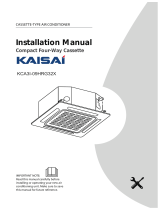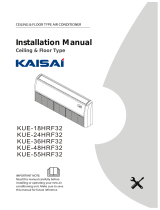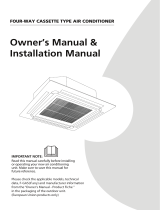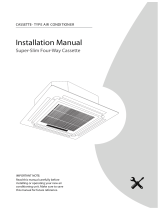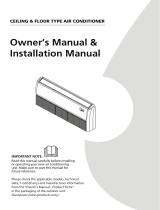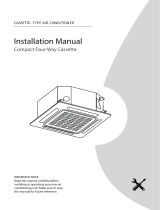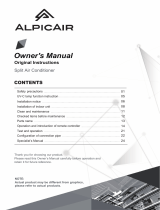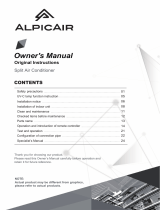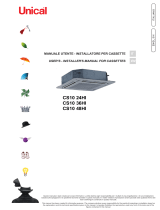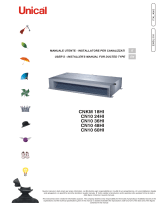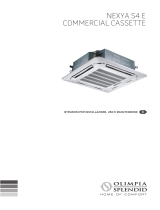Page is loading ...

CASSETTE-TYPE AIR CONDITIONER
Installation Manual
Compact Four-Way Cassette
IMPORTANT NOTE:
Read this manual carefully before
installing or operating your new air
conditioning unit. Make sure to save
this manual for future reference.

Indoor Unit Parts ........................................ 10
Indoor Unit Installation Instructions ....... 11
Outdoor Unit Installation ......................... 14
Outdoor Unit Installation Instructions ...... 14
Drain Joint Installation ................................. 16
Notes on Drilling Hole in Wall ................... 16
Drainpipe Installation ............................... 17
Table of Contents
Installation Manual
Indoor Unit Installation ........................... 10
4
3
5
Indoor Unit Installation ........................... 07
Accessories
....................................................
04
Safety Precautions
.....................................
09
1
2

Page 3
Refrigerant Piping Connection ....................... 19
Notes on Pipe Length and Elevation .............. 19
Refrigerant Piping Connection Instructions ...20
Wiring ................................................. 23
Outdoor Unit Wiring .................. 24
Indoor Unit Wiring ..................... 25
Air Evacuation .................................................. 26
Evacuation Instructions ................................ 26
Note on Adding Refrigerant ....................... 27
Test Run .............................................................................. 30
6
7
8
10
Panel Installation ....................................................... 28
9
L N
MC MC
European Disposal Guidelines .................... 31
11
............................................. 32
12
(for R32/R290 refrigerant only )
Caution : Risk of fire
WARNING:
Servicing shall only be performed as recommended by the equipment
manufacturer.
Maintenance and repair requiring the assistance of other skilled
personnel shall be carried out under the supervision of the person
competent in the use of ammable refrigerants. For more details ,
please refer to the section of “ Information on servicing” .
(This is only required for the unit adopts R32/R290 Refrigerant).
Information Servicing

Page 4
Safety Precautions 1
Read Safety Precautions Before Installation
Incorrect installation due to ignoring instructions can cause serious damage or injury.
The seriousness of potential damage or injuries is classified as either a WARNING or CAUTION.
WARNING
Failure to observe a warning may result in death. The appliance must be installed in
accordance with national regulations.
Failure to observe a caution may result in injury or equipment damage.
CAUTION
WARNING
1. Carefully read the Safety Precautions before installation.
2. In certain functional environments, such as kitchens, server rooms, etc., the use of
specially designed air-conditioning units is highly recommended.
3. Only trained and certied technicians should install, repair and service this air
conditioning unit.
4. Improper installation may result in electrical shock, short circuit, leaks, fire or other
damage to the equipment and personal property.
(In North America,installation must be performed in accordance with the requirement
of NEC and CEC by authorized personnel only.)
5. Strictly follow the installation instructions set forth in this manual.
6. Before you install the unit, consider strong winds, typhoons and earthquakes that might
aect your unit and locate it accordingly. Failure to do so could cause the equipment to
fail.
7. This appliance can be used by children aged from 8 years and above and persons with
reduced physical, sensory or mental capabilities or lack of experience and knowledge if
they have been given supervision or instruction concerning use of the appliance in a safe
way and understand the hazards involved. Children shall not play with the appliance.
Cleaning and user maintenance shall not be made by children without supervision.
(EN Standard requirements)
8. Do not use means to accelerate the defrosting process or to clean, other than those
recommended by the manufacturer.
9. This appliance is not intended for use by persons(including children) with reduced
physical, sensory or mental capabilities or lack of experience and knowledge, unless
they have been given supervision or instruction concerning use of the appliance by a
person responsible for their safety.(IEC Standard requirement )
10. Children should be supervised to ensure that they do not play with the appliance.
(IEC Standard requirement )
This symbol indicates that you must never perform the action indicated.

Page 5
WARNING
For units that have an auxiliary electric heater, do not install the unit within 1 meter (3 feet)
of any combustible materials.
Do not install the unit in a location that may be exposed to combustible gas leaks. If
combustible gas accumulates around the unit, it may cause re.
Do not
operate your air conditioner in a wet room such as a bathroom or laundry room. Too
much exposure to water can cause electrical components to short circuit.
1.
The product must be properly grounded at the time of installation, or electrical shock may occur.
2. Install drainage piping according to the instructions in this manual. Improper drainage may
cause water damage to your home and property.
CAUTION
11. If the supply cord is damaged, it must be replaced by the manufacturer,its service agent
or similarly qualied persons in order to avoid a hazard.
12. The appliance shall be installed in accordance with national wiring regulations.
13. An all-pole disconnection device which has at least 3mm clearances in all poles, and
have a leakage current that may exceed 10mA,the residual current device (RCD) having
a rated residual operating current not exceeding 30mA,and disconnection must be
incorporated in the xed wiring in accordance with the wiring rules.
14. The appliance disconnection must be incorporated with an all-pole disconnection
device in the xed wiring in accordance with the wiring rules.
15. Any person who is involved with working on or breaking into a refrigerant circuit
should hold a current valid certicate from an industry-accredited assessment authority,
which authorises their competence to handle refrigerants safely in accordance with an
industry recognised assessment specication.
16. Servicing shall only be performed as recommended by the equipment manufacturer.
17. Maintenance and repair requiring the assistance of other skilled personnel shall be
carried out under the supervision of the person competent in the use of ammable
refrigerants.
18. The appliance shall be stored so as to prevent mechanical damage from occurring.
19. Keep ventilation openings clear of obstruction.
20. Do not turn on the power until all work has been completed.
21. When moving or relocating the air conditioner, consult experienced service technicians
for disconnection and reinstallation of the unit
22. In certain functional environments, such as kitchens, server rooms, etc., the use of
specially designed air-conditioning units is highly recommended.
23. Removal of the plug has to be such that an operator can check from any of the points to
which he has access that the plug remains removed.
24. If this is not possible, due to the construction of the appliance or its installation, a
disconnection with a locking system in the isolated position shall be provided.
25. How to install the appliance to its support, please read the information for details in
"indoor unit installation" and "outdoor unit installation".

Page 6 Page 6
1.
Cautions for using R32/R290 refrigerant
Installation (Space)
- That the installation of pipe-work shall be kept to a minimum.
- That pipe-work shall be protected from physical damage.
- That compliance with national gas regulations shall be observed.
- That mechanical connections shall be accessible for maintenance purposes.
- In cases that require mechanical ventilation, ventilation openings shall be kept clear of
obstruction.
- When disposing of the product is used, be based on national regulations, properly processed.
-The appliance shall be stored in a well-ventilated area where the room size corresponds
to the room area as specied for operation.
-Spaces where refrigerant pipes shall be compliance with national gas regulations.
2. Servicing
- Any person who is involved with working on or breaking into a refrigerant circuit should
hold a current valid certicate from an industry-accredited assessment authority, which
authorises their competence to handle refrigerants safely in accordance with an industry
recognised assessment specication.
- Servicing shall only be performed as recommended by the equipment manufacturer.
Maintenance and repair requiring the assistance of other skilled personnel shall be carried
out under the supervision of the person competent in the use of ammable refrigerants.
Do not use means to accelerate the defrosting process or to clean, other than those
recommended by the manufacturer.
The appliance shall be stored in a room without continuously operating ignition sources
(for example: open ames,an operating gas appliance or an operating electric heater)
Do not pierce or burn.
Be aware that refrigerants may not contain an odour.
Be more careful that foreign matter(oil, water,etc) does not enter the piping. Also, when
storing the piping, securely seal the opening by pinching, taping, etc.
For indoor units, use R32 areless joint assy only when connecting the indoor unit and
connecting piping(when connecting indoors). Use of pipes, areless nut or are nuts other
than specied, may cause product malfunction, burst piping, or injury due to high internal
pressure of the refrigerant cycle caused by any inow air.
Appliance shall be installed, operated and stored in a room with a oor area larger than
X m² (Please see the following form ). The appliance shall not be installed in an
unventilated space, if that space is smaller than X m² (Please see the following form ).
3.
4.
5.
6.
7.
8.

Page 7
Table.1-1
Table.1-2
Note about Fluorinated Gasses
1.
This air-conditioning unit contains fluorinated greenhouse gasses. For specic information
on the type of gas and the amount, please refer to the relevant label on the unit itself or the
“Owner's Manual - Product Fiche ” in the packaging of the outdoor unit. (European
Union products only).
2. Installation, service, maintenance and repair of this unit must be performed by a certified
technician.
3. Product uninstallation and recycling must be performed by a certified technician.
4. For equipment that contains uorinated greenhouse gases in quantities of 5 tonnes of CO
equivalent or more, but of less than 50 tonnes of CO equivalent, If the system has a leak-
detection system installed, it must be checked for leaks at least every 24 months.
2
2
5.
When the unit is checked for leaks, proper record-keeping of all checks is strongly
recommended.
R32
Refrigerant
Type Installation
Height H0(m)
LFL(kg/m )
3Floor Area (m )
2
0.306
0.6
1.0
1.8
2.2
4
0.68
1.14
2.05
2.50
7
0.90
1.51
2.71
3.31
10
1.08
1.80
3.24
3.96
15
1.32
2.20
3.97
4.85
20
1.53
2.54
4.58
5.60
30
1.87
3.12
5.61
6.86
50
2.41
4.02
7.24
8.85
Max Refrigerant Charge (kg)
R32
LFL(kg/m )
3Charge Amount in kg
0.306
0.6
1.0
1.8
2.2
1.224 1.836
29
10
3
2
2.448
51
19
6
4
3.672
116
42
13
9
4.896
206
74
23
15
6.12
321
116
36
24
7.956
543
196
60
40
Min. Room Area (m )
2
Minimum Room Area ( m )
2
Refrigerant
Type Installation
Height H0(m)

Page 8
CAUTION
CAUTION
CAUTION
This symbol shows that a service personnel should be handling this
equipment with reference to the installation manual.
This symbol shows that information is available such as the operating
manual or installation manual.
This symbol shows that this appliance uses a ammable refrigerant. If the
refrigerant is leaked and exposed to an external ignition source, there is a
risk of re.
This symbol shows that the operation manual should be read carefully.
WARNING
CAUTION
Explanation of symbols displayed on the indoor unit or outdoor unia
(applicable to the unit adopts R32/R290 Refrigerant only):

Page 9
Accessories
Accessories
2
The air conditioning system comes with the following accessories. Use all of the installation parts
and accessories to install the air conditioner. Improper installation may result in water leakage,
electrical shock and fire, or cause the equipment to fail.
Name Shape Quantity
Indoor unit
installation Installation paper template
(some models) 1
Refrigeration
Fittings
Insulation for gas pipe
tting (some models)
Insulation for liquid pipe
tting (some models)
1
Drainpipe
Fittings
Outlet pipe sheath (some
models) 1
Outlet pipe clasp (some
models) 1
Drain joint (some models) 1
Seal ring (some models) 1
Installation
Accessory
(some
models)
Ceiling hook
Copper nut
(some units)
4
2
Suspension bolt 4
Throttle (some units) 1
Anti-shock rubber 1
1
1
1
1
Owner’s manual
Installation manual
1
Optional accessories
There are two types of remote controls: wired and wireless.
Select a remote controller based on customer preferences and requirements and install in an
appropriate place. Refer to catalogues and technical literature for guidance on selecting a
suitable remote controller.
This indoor unit requires installation of an optional decoration panel.
•
•
EMC Magnetic
Ring (some
models)
Magnetic ring (wrap the
electric wires S1 & S2
( P & Q & E ) around
the magnetic ring twice)
Magnetic ring (Hitch it on the
connective cable between
indoor unit and outdoor unit
after installation.)
S1&S2(P&Q&E)
Used to make the
connective pipes
between indoor and
outdoor units.
Others

Page 10
Indoor Unit
Installation
Indoor Unit Installation 3
Indoor Unit Parts
(within indoor unit)
Drain pipe
Drain pump
Air outlet
Air inlet
Display panel
Front grille
Louver
Refrigerant pipe
Fig. 3.1
Safety Precautions
WARNING
• Securely install the indoor unit on a
structure that can sustain its weight. If the
structure is too weak, the unit may fall
causing personal injury, unit and property
damage, or even death.
• Install the indoor unit at a height of more
than 2.5m (8’) above the floor.
• DO NOT install the indoor unit in a
bathroom or laundry room as excessive
moisture can short the unit and corrode
the wiring.
CAUTION
• Install the indoor and outdoor units, cables
and wires at least 1m (3.2’) from televisions
or radios to prevent static or image
distortion. Depending on the appliances, a
1m (3.2’) distance may not be sufficient.
•If the indoor unit is installed on a metal
part of the building, it must be grounded.

Page 11
Indoor Unit
Installation
Indoor Unit Installation Instructions
NOTE: Panel installation should be done
after piping and wiring.
Step 1: Select installation location
The indoor unit should be installed in a location
that meets the following requirements:
The unit is at least 1m (39”) from the nearest
wall.
There is enough room for installation and
maintenance.
There is enough room for the connecting
pipe and drainpipe.
The ceiling is horizontal and its structure can
sustain the weight of the indoor unit.
The air inlet and outlet are not impeded.
The airflow can fill the entire room.
There is no direct radiation from heaters.
CAUTION
DO NOT install the unit in the following
locations:
In areas with oil drilling or fracking
In coastal areas with high salt content in
the air
In areas with caustic gases in the air, such
as near hot springs
In areas with power fluctuations, such as
factories
In enclosed spaces, such as cabinets
In kitchens that use natural gas
In areas with strong electromagnetic waves
In areas that store flammable materials or gas
In rooms with high humidity, such as
bathrooms or laundry rooms
RECOMMENDED DISTANCES BETWEEN THE INDOOR UNIT AND THE CEILING
The distance between the mounted indoor unit and the internal ceiling should meet the following
specifications. (See Fig. 3.2)
Connecting point
of drain pipe
Connecting point of
refrigerant pipe
(liquid side)
Connecting point of
refrigerant pipe
(gas side)
Front panel
Ground
Ceiling board
>2.5m / 8.2’
60cm / 23.6” (Ceiling hole)
Ceiling
Fig. 3.2
>29cm / 11.4”
26cm / 10.2”

Page 12
Indoor Unit
Installation
CAUTION
The unit body should align perfectly with the
hole. Ensure that the unit and the hole are the
same size before moving on.
2. Drill 4 holes 5cm (2”) deep at the ceiling hook
positions in the internal ceiling. Be sure to hold
the drill at a 90° angle to the ceiling.
3. Using a hammer, insert the ceiling hooks into
the pre-drilled holes. Secure the bolt using the
included washers and nuts.
4. Install the four suspension bolts (See Fig. 3.4).
Step 2: Hang indoor unit.
1. Use the included paper template to cut a rectangular hole in the ceiling, leaving at least 1m (39”)
on all sides. The hole will be 60x60cm (23.6x23.6”) big. Be sure to mark the areas where ceiling
hook holes will be drilled.
Fig. 3.4
Fig. 3.3
545mm / 21.5” (Suspension bolt)
570mm / 22.4”(Body)
647mm / 25.5”(Ceiling opening)
523mm / 20.6”
(Suspension bolt)
570mm / 22.4” (Body)
647mm / 25.5” (Ceiling opening)
Refrigerant piping side
Drain hose side
>1m / 39”
>1m / 39”
>1m / 39”
>1m / 39”

Page 13
Indoor Unit
Installation
5. Mount the indoor unit. You will need two
people to lift and secure it. Insert suspension
bolts into the unit’s hanging holes. Fasten
them using the included washers and nuts
(See Fig. 3.5).
Fig. 3.5
NOTE: The bottom of the unit should be
24mm (0.9”) higher than the ceiling board.
Generally, L (indicated in Fig. 3.6) should be
half the length of the suspension bolt or long
enough to prevent the nuts from coming o.
Fig. 3.6
CAUTION
Ensure that the unit is completely level.
Improper installation can cause the drain pipe
to back up into the unit or water leakage.
Wall
Ceiling board
Main body
24mm (0.9”)
L
NOTE: Ensure that the indoor unit is level.
The unit is equipped with a built-in drain
pump and oat switch. If the unit is tilted
against the direction of condensate ows
(the drainpipe side is raised), the oat switch
may malfunction and cause water to leak.
Water level
Fig. 3.7
NOTE FOR NEW HOME INSTALLATION
When installing the unit in a new home, the
ceiling hooks can be embedded in advance.
Make sure that the hooks do not come loose
due to concrete shrinkage. After installing the
indoor unit, fasten the installation paper
template onto the unit with bolts (M6X12) to
determine in advance the dimension and
position of the opening on the ceiling.
Follow the instructions above for the
remainder of the installation.
Installation template
M6 x 12 Bolts
Main body
Fig. 3.8

Page 14
Outdoor Unit
Installation
Outdoor Unit Installation
Outdoor Unit Installation Instructions
Step 1: Select installation location.
The outdoor unit should be installed in the
location that meets the following requirements:
Place the outdoor unit as close to the indoor
unit as possible.
Ensure that there is enough room for
installation and maintenance.
The air inlet and outlet must not be
obstructed or exposed to strong wind.
Ensure the location of the unit will not be
subject to snowdrifts, accumulation of leaves
or other seasonal debris. If possible, provide
an awning for the unit. Ensure the awning
does not obstruct airflow.
The installation area must be dry and well
ventilated.
There must be enough room to install the
connecting pipes and cables and to access
them for maintenance.
The area must be free of combustible gases
and chemicals.
The pipe length between the outdoor and
indoor unit may not exceed the maximum
allowable pipe length.
If possible, DO NOT install the unit where it
is exposed to direct sunlight.
If possible, make sure the unit is located far
away from your neighbors’ property so that
the noise from the unit will not disturb them.
If the location is exposed to strong winds (for
example: near a seaside), the unit must be
placed against the wall to shelter it from the
wind. If necessary, use an awning.
(See Fig. 4.1 & 4.2)
Install the indoor and outdoor units, cables
and wires at least 1 meter from televisions or
radios to prevent static or image distortion.
Depending on the radio waves, a 1 meter
distance may not be enough to eliminate all
interference.
Strong wind
Strong wind
Strong wind
Fig. 4.1
Fig. 4.2
Step 2: Install outdoor unit.
Fix the outdoor unit with anchor bolts (M10)
>60cm / 23.6”
Fix with bolts
CAUTION
• Be sure to remove any obstacles that
may block air circulation.
• Make sure you refer to Length
Specifications to ensure there is
enough room for installation and
maintenance.
Fig. 4.3
4
√
√
√
√
√
√
√
√
√
√
√
√

Page 15
Outdoor Unit
Installation
Air Outlet
(Wall or obstacle)
H
D
W
Air inlet
Air inlet Air inlet
Air inlet
(Wall or obstacle)
Table 4.1: Length Specifications of Split
Type Outdoor Unit (unit: mm/inch)
Table 4.2: Length Specifications of Vertical
Discharge Outdoor Unit (unit: mm/inch)
MODEL
DIMENSIONS
W H D
18 633/25 554/21.8554/21.8
24 633/25 554/21.8554/21.8
36 759/29.8 554/21.8554/21.8
36 633/25 600/23.6600/23.6
48 759/29.8 710/28710/28
60 843/33 710/28710/28
Split Type Outdoor Unit
(Refer to Fig 4.4, 4.5, 4.6, 4.10 and Table 4.1)
Vertical Discharge Type Outdoor Unit
(Refer to Fig 4.7, 4.8, 4.9 and Table 4.2)
Fig. 4.7
Fig. 4.8
Fig. 4.9
Fig. 4.6
Fig. 4.5
A
B
D
Fig. 4.4
Outdoor Unit Dimensions
W x H x D
Mounting Dimensions
Distance A Distance B
760x590x285 (29.9x23.2x11.2) 530 (20.85) 290 (11.4)
810x558x310 (31.9x22x12.2) 549 (21.6) 325 (12.8)
845x700x320 (33.27x27.5x12.6) 560 (22) 335 (13.2)
900x860x315 (35.4x33.85x12.4) 590 (23.2) 333 (13.1)
945x810x395 (37.2x31.9x15.55) 640 (25.2) 405 (15.95)
990x965x345 (38.98x38x13.58) 624 (24.58) 366 (14.4)
946x810x420 (37.24x31.9x16.53) 673 (26.5) 403 (15.87)
946x810x410 (37.24x31.9x16.14) 673 (26.5) 403 (15.87)
952x1333x410 (37.5x52.5x16.14) 634 (24.96) 404 (15.9)
952x1333x415 (37.5x52.5x16.34) 634 (24.96) 404 (15.9)
845x702x363 (33.27x27.6x14.3) 540 (21.26) 350 (13.8)
938x1369x392 (36.93x53.9x15.43) 634 (24.96) 404 (15.9)
900x1170x350 (35.4x46x13.8) 590 (23.2) 378 (14.88)
800x554x333 (31.5x21.8x13.1) 514 (20.24) 340 (13.39)
>152.4cm / 60”
>45.7cm / 18” >45.7cm / 18”
>45.7cm / 18”
>45.7cm / 18”
W
H
W
H
Outdoor Unit Types and Specifications

Outdoor Unit
Installation
Page 16
M
N
P
30 cm / 11.8” from back wall
60 cm / 23.6” on right
60 cm / 23.6” above
30 cm / 11.8” on left
200 cm / 78” in front
NOTE: The minimum distance between the
outdoor unit and walls described in the
installation guide does not apply to airtight
rooms. Be sure to keep the unit unobstructed
in at least two of the three directions (M, N, P)
(See Fig. 4.10)
Fig. 4.10
Fig. 4.11
NOTE: Make sure the water drains to a safe
location where it will not cause water
damage or a slipping hazard.
Seal
Drain joint
(A) (B)
Base pan hole of
outdoor unit
Seal
Fig. 4.12
Notes On Drilling Hole In Wall
You must drill a hole in the wall for the
refrigerant piping, and the signal cable that will
connect the indoor and outdoor units.
1. Determine the location of the wall hole
based on the location of the outdoor unit.
2. Using a 65-mm (2.5”) core drill, drill a hole
in the wall.
NOTE: When drilling the wall hole, make
sure to avoid wires, plumbing, and other
sensitive components.
3. Place the protective wall cu in the hole.
This protects the edges of the hole and will
help seal it when you nish the installation
process.
Fig. 5.11
L
H
300 cm / 118” or more
A
60 cm / 23.6”
or more
150 cm / 59”
or more
25 cm / 9.8”
or more
25 cm / 9.8”
or more
Rows of series installation
L ≤ H L ≤ 1/2H
L A
25 cm / 9.8” or more
1/2H < L ≤ H
30 cm / 11.8” or more
L H Can not be installed
Table 4.3 The relations between H, A and L
are as follows.
Drain Joint Installation
If the drain joint comes with a rubber seal
(see Fig. 4.12 - A ), do the following:
1. Fit the rubber seal on the end of the drain joint
that will connect to the outdoor unit.
2. Insert the drain joint into the hole in the base
pan of the unit.
3. Rotate the drain joint 90° until it clicks in place
facing the front of the unit.
4. Connect a drain hose extension (not included)
to the drain joint to redirect water from the
unit during heating mode.
If the drain joint doesn’t come with a rubber
seal (see Fig. 4.12 - B ), do the following:
Insert the drain joint into the hole in the base
pan of the unit. The drain joint will click in
place.
Connect a drain hose extension (not included)
to the drain joint to redirect water from the
unit during heating mode.

Drainpipe
Installation
Page 17
NOTE ON DRAINPIPE INSTALLATION
•
When using an extended drainpipe, tighten
the indoor connection with an additional
protection tube to prevent it from pulling
loose.
• The drainpipe should slope downward at a
gradient of at least 1/100 to prevent water
from flowing back into the air conditioner.
• To prevent the pipe from sagging, space
hanging wires every 1-1.5m (40-59”).
•
If the outlet of the drainpipe is higher than
the body’s pump joint, provide a lift pipe for
the exhaust outlet of the indoor unit. The
lift pipe must be installed no higher than
75cm (29.5”) from the ceiling board and
the distance between the unit and the lift
pipe must be less than 30cm (11.8”).
Incorrect installation could cause water to
flow back into the unit and flood.
• To prevent air bubbles, keep the drain hose
level or slightly tiled up (<75mm / 3”).
The drainpipe is used to drain water from the
unit. Improper installation may cause unit and
property damage.
CAUTION
•
Insulate all piping to prevent condensation,
which could lead to water damage.
• If the drainpipe is bent or installed
incorrectly, water may leak and cause a
malfunction of the water- level switch.
• In HEAT mode, the outdoor unit will
discharge water. Ensure that the drain hose
is placed in an appropriate area to avoid
water damage and slippage due to frozen
drain water.
• DO NOT pull the drainpipe forcefully as
this could cause it to disconnect.
NOTE ON PURCHASING PIPES
This installation requires a polyethylene tube
(outside diameter = 3.7-3.9cm, inside diameter
= 3.2cm), which can be obtained at your local
hardware store or from your dealer.
Indoor Drainpipe Installation
Install the drainpipe as shown in Fig 5.2.
1. Cover the drainpipe with heat insulation to
prevent condensation and leakage.
2. Attach the mouth of the drain hose to the
unit’s outlet pipe. Sheath the mouth of the
hose and clip it rmly with a pipe clasp.
(Fig 5.1)
Drainpipe
connecting port
Drain hose
Metal clamp Insulation
Fig. 5.1
Drainpipe Installation 5
Downward slope
1/100
1-1.5m
(39-59”)
Fig. 5.2
Fig. 5.3
≤75cm
(29.5”)
Ceiling
1 - 1.5m
(39-59”)
0 - 75mm
(3”)
≤30cm (11.8”)
≤53cm
(20.8”)
22cm
(8.6”)

Page 18
Drainpipe
Installation
3. Using a 65-mm (2.5”) core drill, drill a hole in
the wall. Make sure that the hole is drilled at a
slight downward angle, so that the outdoor
end of the hole is lower than the indoor end
by about 12mm (0.5”). This will ensure proper
water drainage (See Fig. 5.5). Place the
protective wall cu in the hole. This protects
the edges of the hole and will help seal it
when you nish the installation process.
Wall
IndoorOutdoor
≈ 12mm 0.5 inch
Fig. 5.5
NOTE: When drilling the wall hole, make sure
to avoid wires, plumbing, and other sensitive
components.
4. Pass the drain hose through the wall hole.
Make sure the water drains to a safe location
where it will not cause water damage or a
slipping hazard.
NOTE: The drainpipe outlet should be at
least 5cm (1.9”) above the ground. If it
touches the ground, the unit may become
blocked and malfunction. If you discharge
the water directly into a sewer, make sure
that the drain has a U or S pipe to catch odors
that might otherwise come back into the
house.
NOTE: When connecting multiple drainpipes,
install the pipes as shown in Fig 5.4.
0-53cm
(20.8”)
≥10cm
(4”)
Fig. 5.4

Refrigerant Piping
Connection
Page 19
Refrigerant Piping Connection
Safety Precautions
WARNING
• All eld piping must be completed by a
licensed technician and must comply with
the local and national regulations.
• When the air conditioner is installed in a
small room, measures must be taken to
prevent the refrigerant concentration in
the room from exceeding the safety limit
in the event of refrigerant leakage. If the
refrigerant leaks and its concentration
exceeds its proper limit, hazards due to
lack of oxygen may result.
• When installing the refrigeration system,
ensure that air, dust, moisture or foreign
substances do not enter the refrigerant
circuit. Contamination in the system may
cause poor operating capacity, high
pressure in the refrigeration cycle,
explosion or injury.
• Ventilate the area immediately if there is
refrigerant leakage during the installation.
Leaked refrigerant gas is both toxic and
flammable. Ensure there is no refrigerant
leakage after completing the installation
work.
Notes On Pipe Length and Elevation
Ensure that the length of the refrigerant pipe, the
number of bends, and the drop height between
the indoor and outdoor units meets the
requirements shown in Table 6.1:
Table 6.1: The Maximum Length And Drop
Height Based on Models. (Unit: m/ft.)
Type of model Capacity
(Btu/h) Length of
piping Maximum drop
height
North America,
Australiaand the
eu frequency
conversion Split
Type
<15K 25/82 10/32.8
≥15K - <24K 30/98.4 20/65.6
≥24K - <36K 50/164 25/82
≥36K - ≤60K 65/213 30/98.4
Other Split Type
12K 15/49 8/26
18K-24K 25/82 15/49
30K-36K 30/98.4 20/65.6
42K-60K 50/164 30/98.4
6
Fig. 6.1
Oil traps
CAUTION
•
If the indoor unit is installed higher than the
outdoor unit:
An oil trap should be installed every 10m
(32.8ft) of vertical suction line riser.
(See Fig. 6.1)
-If oil flows back into the outdoor unit’s
compressor, this might cause liquid
compression or deterioration of oil return. Oil
traps in the rising gas piping can prevent this.
The indoor unit is installed higher than the outdoor unit

Refrigerant Piping
Connection
Page 20
Refrigerant Piping Connection Instructions
CAUTION
• The branching pipe must be installed
horizontally. An angle of more than 10°
may cause malfunction.
• DO NOT install the connecting pipe until
both indoor and outdoor units have been
installed.
• Insulate both the gas and liquid piping to
prevent water leakage.
Step1: Cut pipes
When preparing refrigerant pipes, take extra
care to cut and flare them properly. This will
ensure efficient operation and minimize the
need for future maintenance.
For R32/R290
refrigerantmodels, the pipe connection
points must be placed outside of room.
The connection pipes can not be reused.
1. Measure the distance between the indoor
and outdoor units.
2. Using a pipe cutter, cut the pipe a little
longer than the measured distance.
CAUTION
DO NOT deform pipe while cutting. Be extra
careful not to damage, dent, or deform the
pipe while cutting. This will drastically reduce
the heating efficiency of the unit.
1. Make sure that the pipe is cut at a perfect
90° angle. Refer to Fig. 6.3 for examples of
bad cuts.
Oblique
Rough
Warped
90°
Fig. 6.3
Fig. 6.2
CAUTION
If the outdoor unit is installed higher than
the indoor unit:
-It is recommended that vertical suction
risers not be upsized. Proper oil return to
the compressor should be maintained with
suction gas velocity. If velocities drop
below7.62m/s (1500fpm (feet per minute)),
oil return will be decreased. An oil trap
should be installed every 6m(20ft) of
vertical suction line riser. (See Fig. 6.2)
The outdoor unit is installed higher than the indoor unit
/

